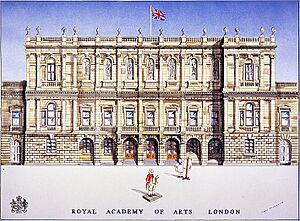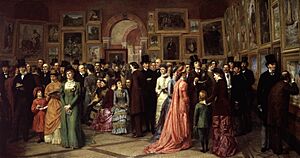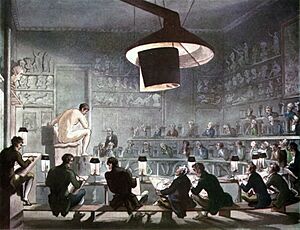Royal Academy of Arts facts for kids
 |
|

Front view, October 2010
|
|
| Established | 1768 |
|---|---|
| Location | Burlington House, Piccadilly, London, United Kingdom |
| Visitors | 709,961 (2023) |
| Public transit access | |
The Royal Academy of Arts (often called the RA) is a famous art place in London, England. It's located in Burlington House in Piccadilly. It was started way back in 1768. What makes it special is that it's an independent organization. This means it gets its money from private sources, not the government. It's also run by well-known artists and architects. The main goal of the Royal Academy is to help people create, enjoy, and understand fine art. They do this through art shows, teaching, and discussions.
Contents
The Royal Academy's Story
The idea for the Royal Academy started around 1755. Some artists wanted to create an independent art school. Before this, artists were part of other groups or small private art schools.
A famous architect named Sir William Chambers helped make the Royal Academy happen. He used his connections with King George III to get royal support. King George III officially founded the Royal Academy of Arts on December 10, 1768. Its mission was to create "a school or academy of design for the use of students in the arts." It also planned to have an art show every year.
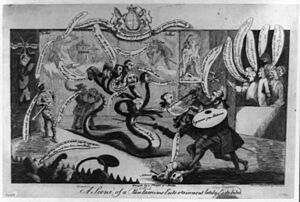
The painter Joshua Reynolds became the first president of the Academy. He was a very important artist at the time.
King George III named 34 artists as the first members. These included famous names like Joshua Reynolds, Thomas Gainsborough, and Angelica Kauffman. The Academy could have up to 40 members in total.
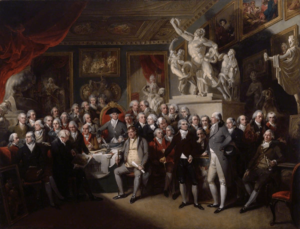
The Royal Academy first started in small rooms in Pall Mall. Later, in 1780, it moved to a special building in New Somerset House. This building was designed by William Chambers. In 1837, the Academy moved again to Trafalgar Square. It shared a building with the National Gallery. But the space became too small for both. So, in 1868, exactly 100 years after it began, the Academy moved to Burlington House in Piccadilly. It has been there ever since!
The first art show for new artists opened on April 25, 1769. It showed 136 artworks. This show, now called the Royal Academy Summer Exhibition, has happened every year since then. It's one of the oldest art traditions in the world.
The Royal Academy also held Britain's first public talks about art. These talks helped teach people about art and its history.
In 2018, the Academy celebrated its 250th birthday! They finished a big renovation project that year. The project added new galleries, a lecture hall, and a bridge. This bridge connects the Burlington House and Burlington Gardens sites. As part of this work, 10,000 artworks from the Academy's collection were put online.
What the Royal Academy Does
How the Academy is Funded
The Royal Academy does not get money from the government or the King. It works as a charity. The building it uses in Burlington House is owned by the UK government. The Academy gets to use it for a very long time for a very small rent.
Art Collection and Special Shows
The Academy has its own collection of art. These artworks are always there for people to see. It also hosts many temporary art shows. These shows often bring in famous artworks from other museums around the world.
Art Exhibitions
The Royal Academy puts on many exciting art exhibitions. These shows feature both old master paintings and modern art. For example, in 2004, the Academy showed an exhibition called "Entangled Pasts, 1768-now." This show explored how art from the Royal Academy connects to Britain's colonial past.
The Summer Exhibition
One of the most famous things the Academy does is its Summer Exhibition. This is an annual art show where anyone can submit their artwork. It's the oldest and largest open art show in the world. Members of the Academy, called Royal Academicians, choose and arrange the artworks. You can see all kinds of art there, like paintings, sculptures, films, and photographs.
In 2007, the artist Tracey Emin became a Royal Academician. She said it showed that the Royal Academy was becoming more open to different kinds of art.
Friends of the Academy
In 1977, a group called the Friends of the Royal Academy was started. This charity helps raise money to support the Academy's work.
Stories and Books
The Academy also hosts events where authors and actors read short stories. These stories are often chosen to go along with the art exhibitions. They also have a writing competition called the RA and Pin Drop Short Story Award. The winning story is read aloud by a special guest at an award ceremony.
Leaders of the Academy
On December 10, 2019, Rebecca Salter became the first female President of the Royal Academy. This was a big moment in the Academy's history.
Royal Academy Schools
The Royal Academy Schools are the oldest art school in Britain. They have been a key part of the Academy since it started in 1768. A great thing about these schools is that their three-year art program is completely free for students who get accepted.
The Schools were the first place in Britain to offer professional training for artists. They taught students to copy famous old artworks. Students also learned to draw from ancient statues and from real people. This training helped artists create beautiful and meaningful works.
Many famous artists studied at the Royal Academy Schools. These include J. M. W. Turner, William Blake, and John Constable. In 1860, Laura Herford became the first woman to enroll as a student. In 2011, Tracey Emin and Fiona Rae became the first women professors of drawing and painting at the Academy.
Library, Archives, and Collections
The Royal Academy has a wonderful collection of art. The first president, Sir Joshua Reynolds, gave his own self-portrait to start the collection. Other founding members also donated their artworks. Today, every new member must donate an artwork that shows their style. This is called a "Diploma Work."
The collection has about a thousand paintings and a thousand sculptures. These artworks show how British art has grown over time. The Academy also has many drawings and sketchbooks by artists from the 1700s onwards.
The Academy's photo collection includes pictures of Academicians, landscapes, and buildings. It also has early portraits from the 1850s.
Special Paintings and Sculptures
Some walls and ceilings in the building are decorated with paintings by Benjamin West and Angelica Kauffman. One of the most special artworks is Michelangelo's Taddei Tondo. This marble sculpture was made in Florence between 1504 and 1506. It's the only marble sculpture by Michelangelo in the United Kingdom. It shows the Virgin Mary, baby Jesus, and the infant St John the Baptist. You can usually see it in the Collection Gallery.
War Memorials
At the entrance of the Academy, there are two memorials. One remembers the students from the Royal Academy Schools who died in World War I. The other honors the soldiers from the Artists Rifles who lost their lives in World War I and World War II.
Becoming a Member
The Royal Academy can have up to 80 members. These members are practicing artists, and they are called Royal Academicians (RA). They are chosen by other members. The Royal Academicians are the ones who run the Academy.
When the Academy first started, it had 40 members. At first, engravers (artists who make prints) couldn't be full members. But in 1853, the membership was increased to 42, and engravers could become full members. In 1922, Annie Swynnerton became the first woman to be an Associate of the Royal Academy.
See also
- 6 Burlington Gardens
- Cork Street, a street behind the Royal Academy with many art galleries
- Royal West of England Academy


